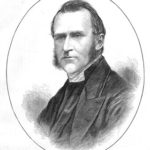[Please note that SEA does not take an official position on millennial views. Members are free to hold any orthodox millennial view. We include this article on our website in recognition of its authorship by a leading Arminian author of the past and appearance in a classic Arminian journal.]
Daniel Steele (1824-1914) was the theologian of the American holiness movement. Most of his works have been reprinted. Yet no one within the holiness movement opposed premillennialism more than Daniel Steele. It is an irony of history that the holiness movement revered Steele, but embraced the very teaching he opposed. In our final issue before Y2K, in this climate of doomsday eschatology, it is appropriate that we reprint a piece by Steele that has not been reprinted by the holiness movement. This was the last published work of Daniel Steele and appeared in The Methodist Review, Vol. 93 (May 1911): 405-415. It has been abridged to fit the constraints of this magazine. To read it in its unabridged form, visit the Independent Methodist Arminian Resource Center
http://www.ldl.net/~cartbury/index.html
There are two theories of Christian eschatology. The first is that the present dispensation of the Holy Spirit will continue until all nations will be evangelized. “The fullness of the Gentiles be come in,” drowning out the unbelief of the Jews until “all Israel shall be saved.” After this period of gospel triumph, Christ will wind up the probationary history of the human race by the simultaneous resurrection of the good and the bad and the general judgment.
The second theory is that the purpose of Christ’s second coming is to set up for the first time his kingdom on the earth. He will reign in person on the throne of David in Jerusalem for a thousand years, attended by a bodyguard of angels and by the risen and glorified saints. Christ will appoint the most dignified saints as governors of the various countries of the globe, ruling over mortals who are eating and drinking, sowing and reaping, marrying and bearing children. Meanwhile thousands will be converted, beginning with the Jews. They will preach the true Messiah to all the world. This theory is called premillennialism.
We propose to show that this scheme, while having elements which fascinate the carnal mind and attract a certain class of spiritual people who “love his appearing,” is at variance with the Holy Scriptures. It proceeds upon arbitrary and false principles of interpretation, yet dodges the absurd conclusions it brings. It lacks coherence as a system, making no provision for some of the most important future events in the history of our race, and endangering some of the most precious Christian doctrines.
1. The whole system is based on a single text of Scripture. Revelation 20:1-8 is located in the most figurative, the most misunderstood book. There is no hint of the second advent of Christ until the general judgment in verse 11. The saints who reign with him are not said to reign with him on the earth. “Live” does not necessarily imply a bodily resurrection, as we will show further on.
2. Premillennialism is grounded on the false assumption that the kingdom of Christ will not be established until the King visibly descends from heaven. Therefore, John was mistaken when in the wilderness he preached, “The kingdom of heaven is at hand.” When Jesus said to Pilate, “My kingdom is not of this world,” he was thinking of the throne of David in Jerusalem, on which, after nineteen hundred years, he would sit. Thus the Jews were justified in rejecting the Messianic kingdom.
We are told it was not a real kingdom and that the prophecies relating to that kingdom are yet to be fulfilled. They forget Peter’s conclusion, “THEREFORE let all the house of Israel know assuredly that God hath made this same Jesus whom ye crucified, both LORD and CHRIST.” This places the premillennialist and the unbelieving Jews in the same class. Both hold the same error by asserting that Christ’s victory over death was not the beginning of his spiritual kingdom. However, the Te Deum declared, “When thou hadst overcome the sharpness of death thou didst open the kingdom of heaven to all believers” (see Acts 2:29-36).
This kingdom of righteousness, peace, and joy in the Holy Spirit is administered by Christ, enthroned above, through the Paraclete sent down from the Father through his intercession. He now has “the key of the house of David.” The key is the symbol of power. He is now on the throne of David “to order his kingdom in righteousness.” The government is now upon his shoulder. “He is the Prince of life” now.
3. The general resurrection gives premillennialists much trouble. They claim that the millennium will far exceed the present dispensation in the numbers of converts. But what will be done with them The Scriptures abundantly prove that the Church will be complete at the second coming of its Head. The Church is his bride, which he will present to himself as his own at his coming (1 Cor 15:23; Eph 5:25; 1 Thess 1:10; 3:13). These texts demonstrate the completeness of the church at Christ’s coming.
So embarrassed have been some modern premillennialists by this difficulty, arising from the absolute completeness of the Church at the second advent, that they have invented two kinds of Christians: the Bride of Christ and a less intimate relationship. This is the absurdity to which our premillennial friends are driven, rather than admit that there is not the shadow of a New Testament proof that one sinner will be converted after the second coming of Christ.
4. The simultaneous resurrection of all the dead at Christ’s future coming allows no place for the subsequent millennium. To relieve this perplexity, two resurrection are invented – that of the righteous, when the judge descends, and that of the wicked, a thousand years afterward, for which premillennialists quote Rev. 20:11-15, their only proof.
That the dead, the good and the bad, arise together is proven by many scriptures. “And many that sleep in the dust shall awake; some to everlasting life, and some to shame and everlasting contempt.” This is paralleled in John 5:28, “The hour cometh when all who are in their graves shall hear his voice and come forth, they that have done good . . . and they that have done evil . . . .” Here is unquestionable simultaneousness. The expression, “I saw the dead, small and great standing before the throne,” implies the entire human race raised from the death together. The contemporaneous resurrection of “both the just and unjust” is asserted by Paul in Acts 24:15. Paul declared that “God has appointed a day in which he will judge the world.”
The only text which is quoted in proof of the resurrection of the saints before the thousand years is this figurative scripture in which “lived” is regarded as a literal resurrection, “I saw the souls of them that had been beheaded for the testimony of Jesus, . . . and they lived and reigned with Christ a thousand years. This is the first resurrection.” We cannot interpret this resurrection as anything other than a metaphor since only souls were seen. “Lived” does not necessarily indicate physical life; it sometimes means spiritual life, as when Christ says, “Because I live, ye shall live also.”
Difficulties thicken as we apply literalism to the study of the words “and they lived and reigned with Christ a thousand years.” If this means that their happy souls with Christ will rejoice over the long period of prosperity enjoyed by the Church on the earth before a period of spiritual decline, there is no difficulty. But to say that risen and glorified saints are to live and reign with Christ for a period of only a thousand years is totally unlike the language of Scripture in every other place, which assures us that we are to be forever with the Lord.
5. We are told by premillennialists that the saving of souls is to go on upon the earth after the Redeemer’s second appearing. If this be true, all the means of grace will continue.
In awakening sinners what is the most effectual motive The coming of Christ, “revealed from heaven with his mighty angels, . . . who shall punish with everlasting destruction . . . them that obey not the gospel.” “The day of the Lord will come as a thief in the night.” “The Son of man cometh when ye think not.” “As it was in the days of Noah, . . . even thus shall it be when the Son of man shall be revealed.” The futurity of the coming of Christ is everywhere urged as a motive to repent. This motive can be of no avail after this solemn and decisive event is past.
In the training of disciples and the development of Christian character the same motive is urged: “Occupy till I come.” “Be patient therefore, brethren, unto the coming of the Lord.” “The Lord . . . shall give the crown . . . to all them that love his appearing.” Such incentives to holiness abound. Faith rests upon the first coming of our Savior and hope looks forward to the second. He says, “My reward is with me, to give every man according as his work shall be.” No such motives to purity will exist after Christ’s advent.
6. The ordinance of baptism, which, though not saving, is a channel of grace to the penitent believer, does not extend beyond the end of the world, or age. “Go ye and disciple all nations, baptizing them, teaching them, . . . and, lo, I am with you always even to the end of the world.” This will leave no outward public sign of renouncing the devil and all his works and of allegiance to King Jesus.
The Scriptures give no hint of a substitute for this initiatory, sealing ordinance in the millennium after Christ shall come. Nor is there any substitute for “teaching” after that decisive event. This includes preaching as well as Bible classes and Sunday schools.
The Lord’s Supper, a very precious channel of grace, will share the fate of baptism, and disappear at the descent of its Founder, “For as often as ye eat this bread, and drink this cup, ye do show the Lord’s death till he come.” Hence the millennium cannot be a Christian era if the institutes of the gospel having become obsolete.
7. The connection between Christ’s continued work of the Spirit and for saving purposes, the continual intercession of Christ is shown in John 7:38-39; 14:16, 26, 36, and 16:7, 14; Acts 2:33; Titus 3:5-6. The cessation of Christ’s intercessions at his second coming will terminate all the offices of the Holy Spirit on the hearts of men. As the Paraclete was sent down to do the work of Christ when he returned to his Father, he will withdraw when Christ returns to the earth in his glorified humanity. How can sinners repent of their sins, be born again, have assurance of sonship, and be sanctified, after the divine Reprover of sin, the Author of the new birth, the Witness of adoption, and the Sanctifier, has withdrawn from the earth
8. We cannot adopt premillennialism because of the confusion and inconsistency respecting the kingdom of Christ. Some of them teach it is not a growth, but a sudden miraculous creation; that the Christian Church has nothing to do with it; that Jesus will bring it from a far country; that, unlike the church, it will not be “a mixture of the good and the bad.”
But the parables of Christ teach that the kingdom is a growth like the mustard plant, as assimilating principle like leaven, a moral mixture, good and bad fish in the net, drawn to the shore, and tares growing with the wheat till the harvest at the end of the world, which is synonymous with the second advent. The pessimistic doctrine is also taught that the church will wax worse and worse until Christ comes. Premillennialists assert that leaven is a corruption principle, forbidden by the ceremonial law. But Christ distinctly declares that the kingdom of God is like leaven, like a field sown with both wheat and tares, like a dragnet with good and bad fish, and that this mixture ends when the world ends at the coming of Christ to separate the wicked from the just and to wind up the history of mankind on the earth. This same doctrine is implied in the great commission and in all the great creeds of the church.
9. In order to wedge in the millennium between the coming of Christ and the end of probation, the Day of Judgment as well as the general resurrection must be broken into fragments and be strung along a thousand years. The Plymouth Brethren deny that the persons of the saints will ever be judged, Christ having been judged and punished for them on the cross. But their works will be judged at the coming of Christ, to determine their rewards, in the form of offices which Christ will then distribute according to merit.
Neither the denial of the judgment of a part of mankind nor the postponement of another part a thousand years can be harmonized with the Scriptures. In Rev 21:7-8, the overcomer and the coward are simultaneously judged. In Matt 16:24-27 the loser and the saver of his life are judged when the Son of man shall come, and then he shall reward every man according to his works. In Matt 7:21-23 we have the admission and the exclusion both at once, “in that day.” In 25:10 the virgins are judged in the same night, the foolish and the wise; verses 31-46, the most awful and solemn words in the whole range of literature, are too plain to be disfigured by any explanation. In 13:30, 38-43, the tares and the wheat; in Acts 17:31, an appointed day to judge the world; in Rom 2:5-16, “the day of wrath” to some, and of “glory” to others; 2 Cor 5:9-11, “all appear” and receive according to their deeds, “whether . . . good or bad”; see also 1 Cor 4:5 and 3:12-15; Col 1:28; Heb 13:17; 1 Thess 2:19-20. In Rom 14:10, 12 all stand before the judgment seat; see also 2 Pet 3:7, 10, 12.
10. Finally, we raise the question, What would be the effect of preaching to sinners that the visible coming of Christ was not to judge and condemn the impenitent, but to set up a glorious earthly kingdom and to invite all men into it after having sentenced Satan to prison for a term of a thousand years Would it not furnish a motive to defer repentance because it would be easier when the world should be held in awe by the power and glory of the divine King who has suddenly set up his throne in Jerusalem If the devil’s business of tempting men to sin is suspended, so that two of the three great enemies to the Christian life are out of the way, leaving only the flesh to be vanquished, it would have this procrastinating effect.
Would not premillennialism hinder the Jew from confessing Christ as Messiah Would he not think it best to wait until Christ shall be enthroned in Jerusalem and the Jews are hastening to do him homage and hail him as their Messiah We think he would take his chances of living till that event, when he can avoid persecution by going with the crowd into the kingdom. It would be the same as to say to Christ, “We believe in you because you have now come to our terms – making your advent as an all-conquering Deliverer, as you should have come at first.” Can faith and sight coexist Are they not everywhere in the Scriptures contrasted
Having spoken in negative terms throughout this article, let me use positive terms. I believe the millennium is the present state of grace developed more widely and fully than in the early stages of the gospel. Its beginning and end will follow the law of all other great periods of church history, being uncertain and gradual, so excluding slothfulness and false security. It, keeps the church full of missionary activity, but yet in the fitting attitude of expectancy, while nation after nation, like Ethiopia, “shall stretch out their hands unto God.”
Steele, Daniel. “Why I Am Not A Premillenialist.” The Arminian: A Publication of the Fundamental Wesleyan Society, vol. 17, no. 2, 1999. http://wesley.nnu.edu/arminianism/the-arminian-magazine/issue-2-fall-1999-volume-17/. Print.





